About us
- Project Overview
- Concept
- Safe mountain climbing
- Safe rock climbing
- Gift sertificates
- Courses
- Feedback
-
Articles
-
Lirics, enigmas and misterios of mountain climbing
- Climbing psychology
- Kamchatka sea lions
- Ten best mountains of the world
- Machu Picchu Mystery
- Menorca - the mystery of the Talaiots
- Russian climbing reality
- The Camel
- Dyatlov group tragedy - version with no mystics
- Abandoned lighthouse
- Gaucho Argentina
- Horses and mountains
- Akershus Fortress
- Bergen, Norway
- Black Ufany forest
- The Pilot's ring
-
Stories about alpine climbing trips
- South Ushba via 3 buttress
- Ojos del Salado Arg side 2023
- Khan Tengri Edge of risk
- Dykh Tau and Bezengi 2023
- Mount Belukha - the Princess of Altai
- Climbing Alpamayo 2023
- Season 2023 completed
- Season 2023 specifics
- Climbing Monblan 2022
- Lifeless Sierra smiles
- Cerro Torre 50
- Siula Grande
- Climbing Kazbek. Georgia
- Ushba mountain beach
- North Ushba climb
- Morocco, Toubkal climbing
- The Life of the Valley of Sun
- Ushba. Forbidden Mountain
- Peak Lenin Climb
- Kilimanjaro climb
- Elbrus. Today, yesterday and tomorrow
- Mount Kenya climb
- Wind, Rocks and South Cross
- Kluchevskaya Sopka climb
- Peru climbing
- Touching the Legend
- Solo climb of Matterhorn
- Elbrus. Interview with rescuer
- Elbrus - the live legend
- Tian Shan, Peak Komsomol climb
- Khan Tnegri from the North
- International Ushba climb 2002
- Ushba 2002. Author Sergey Zabrodin
- Svanetia, Caucasus from the South
- Climbing Matterhorn - first article
- Climbing Belukha, Altay
-
Rockclimbing stories
- Menorca rockclimbing
- Tenerife rockclimbing
- Climbing in Mallorca January 2023
- Montserrat
- Majorca rockclimbing report 2014
- Rockclimbing in Peru - Huaraz 2023
- Mallorca rockclimbing December 2023
- Brazil rockclimbing
- Canary Islands and Tenerife
- Georgia Rockcimbing
- Madagascar rockclimbing
- Rockclimbing trip to Kalymnos, Autumn 2014
- Rockclimbing trip to Kalymnos, Spring 2014
- Rockclimbimg in Cuba
- Quadras or the architecture of the gods
- Rockcliming Armenia
- Cuba far away
- Crimea winter Rockclimbing
- Gear reviews, repairs, fails
- Iceclimbing trip stories
-
Lirics, enigmas and misterios of mountain climbing
- Codex of Mountain Guide
Touching the Legend
Read in Telegram in English
Leer en Telegram en Español
Matterhorn climbing program
Alpine Club and Climbing School MCS AlexlClimb
The impossible becomes reality, and the sky falls to your feet...
Time flows differently for mountains and people; human centuries are just seconds for imperturbable stone giants. People come and go, generation follows generation, the history of mankind washes the cold granite like wind, leaving no trace on it...

Mount Matterhorn
Only for impossibly short moment the rocks will retain the warmth of human hand, the mountain echo will repeat for a moment the sound of a living voice. And everything calms down again. The mountains were before man, and will be after him, unchanging in their cold grandeur, impregnable guardians of eternity...
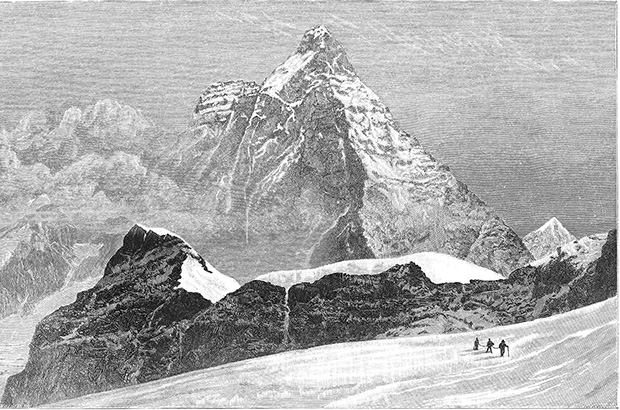
The silhouette of this peak has always excited the imagination of artists and adventurers
Mid-19th century. Europe takes a step into the future - airplane, telegraph, and dynamite are invented. Russia is abolishing serfdom, America is fighting in hysterics of civil war...
The reforms are completely changing the way of life of millions of people. Behind the thunder of great world events, a seemingly imperceptible, modest achievement was almost lost - several brave people unite to solve the most difficult task for that time and achieve success together. A first man has set his foot on the top of the most difficult and inaccessible Alpine mountain - Matterhorn...
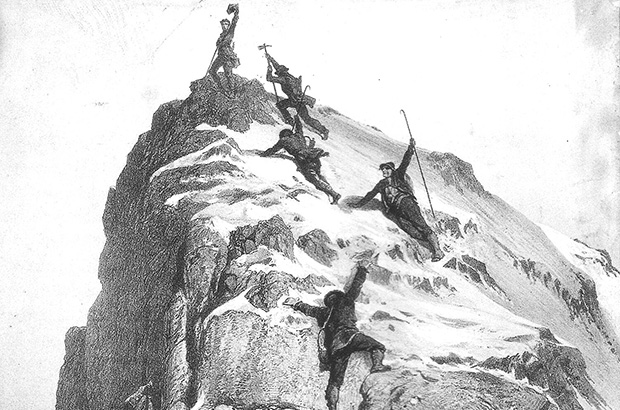
First ascent of Mount Matterhorn on July 14, 1865 by the team led by Edward Whymper (UK) - most part of team died on the descent
Almost a century has passed since a group of adventurers climbed Mont Blanc in 1786 and proved to the whole world that the snow-white mountain peaks were accessible for climbing. Mountaineering found its adherents and became a fashionable popular activity. In the civilized Alps there was only one peak left unconquered by climbers - Mount Matterhorn.
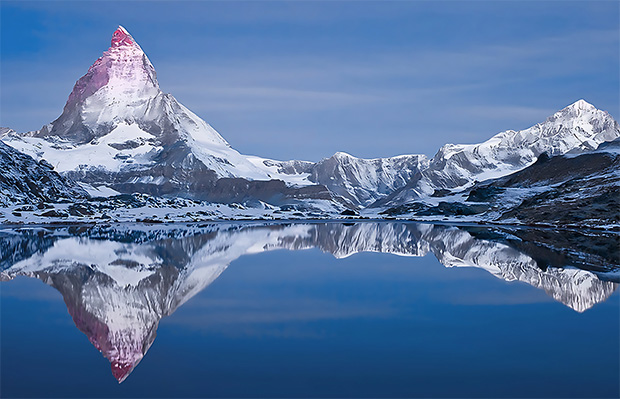
Mount Matterhorn at dawn, photo from the Swiss side
And until today, this giant rocky tooth, grinning predatorily at the sky, does not leave indifferent those who, by the will of fate, were given the opportunity to witness this grandiose spectacle...
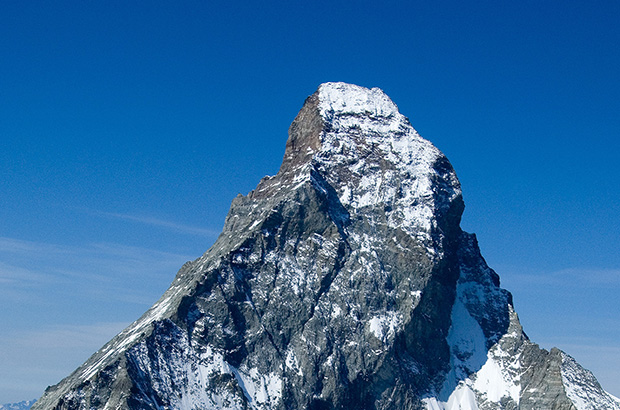
East side of the Matterhorn. Today, along this vertical face there are at least 6 routes of the top difficulty
On July 14, 1865, a team of seven people began their ascent along the route now known as Hörnli Ridge. This climbing team was led by the famous British climber and traveler of that time, Edward Whymper. Along another (opposite) route, from Italy, another team was climbing at the same time, led by the Italian guide and strongest climber Jean-Antoine Carrel.

Jean-Antoine Carrel, born 1829, died of exhaustion on the side of the Matterhorn after climbing with clients on August 26, 1891
The reason for the simultaneous ascent was a bet about who would be the first to reach the desired and inaccessible goal - Summit of Matterhorn. Of course, the issue of national pride played a significant role - for Carrel being Italian it was difficult to accept the fact that the first climber on the top of the Matterhorn could be British...

Carrel's opponent in the first climb of Matterhorn was British climber Edward Whymper
The route from Switzerland chosen by Whymper - the North Ridge (Hörnli) unexpectedly turned out to be much simpler than the route along the South ridge taken by Carrel. The British climber won the “race for the Summit” by assenting Matterhorn several hours ahead of his rival. But competitions in the mountains never led to anything good. And Whymper’s win would be hard to call a victory...
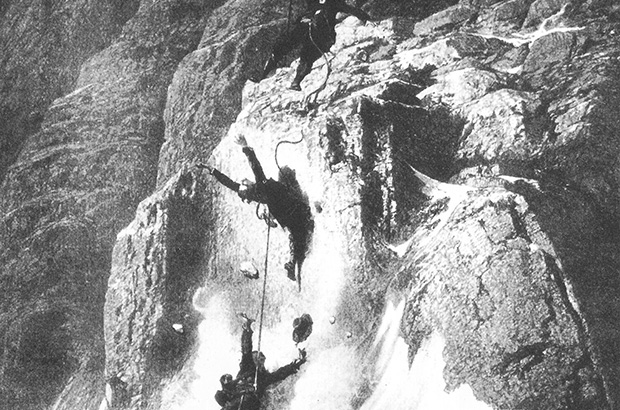
Fatal fall of Whymper's group on the descent from the Matterhorn
Of the seven participants of the climb, only three managed to get back. Four climbers died after falling into the abyss. According to the version proposed by Whymper, the rope with which everyone was connected, after a common fall, broke between him and his partner, leaving the three climbers a chance for salvation.
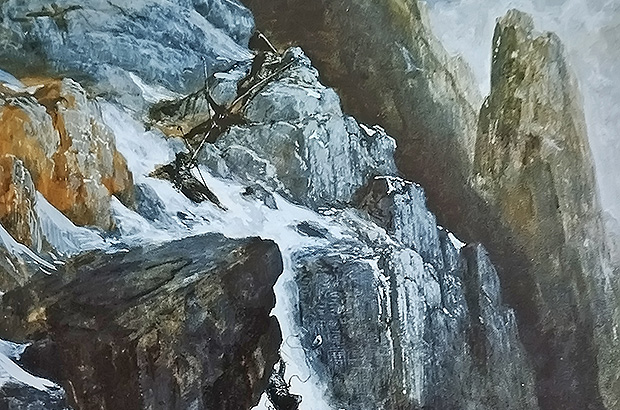
Whymper's conquest of the Matterhorn also ushered in an era of serious mountaineering accidents
However, after the descent of the survivors down in Zermatt, where Whymper hired a team for his ascent, not everyone believed in this explanation. Some people suspect that the rope had been cut - the edges of the rope parts looked too smooth. The truth was never found. A mute witness to this long-standing tragedy, a disheveled piece of that same rope, is still carefully preserved in the mountaineering museum in Zermatt.

A piece of rope with which Whymper survived after most of his group fell
On the other route, Carrel's team, having lost the chance to become the first on the most difficult alpine mountain, abandoned the competition just 200 meters before the summit. Their ascent was completed to the Summit two days later and ended with the entire team successfully descending.
The route along the South Ridge (Liongrat) has forever remained associated with the name of the famous Italian guide and climber Carrel. Until now, this line of ascent of Mount Matterhorn is one of the most difficult climbing routes in the Alps.
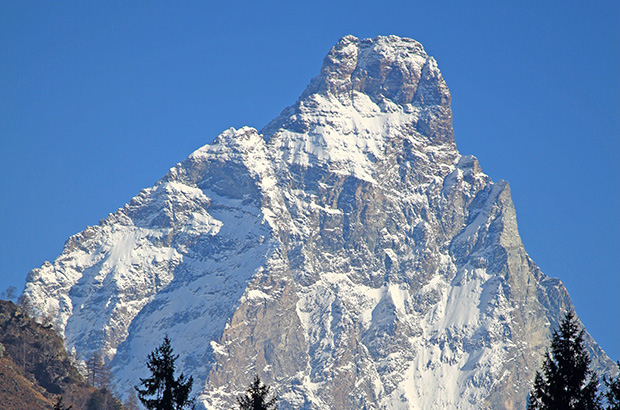
Carrel's route to Mount Matterhorn (from this side the mountain is called Cervino) runs along the left skyline ridge
Climbing Mount Matterhorn along the Liongrat route (Carrel's classic route, from Italy) in these days, you can't help but think about those people, the pioneers.
The level of technological progress has made the impossible possible for us; on the route we use the most modern, lightweight and reliable mountaineering equipment, high-tech clothing designed specifically for being used in the mountains. We stop for the night in a comfortable hut, equipped with radio, solar panels, kitchen and comfortable sleeping places...
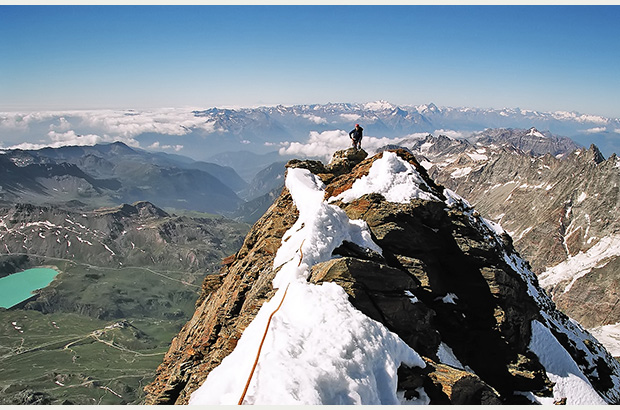
Climbing the rocky ridge of Tyndall Peak - on the way to the summit tower of Mount Matterhorn, Carrel route
How did people do this climb almost 150 years ago? Without any support of the modern progress? What strength of spirit led them up through the snow, cold, and steep icy cliffs? This is the question that mostly interests me. I don't think that the value of human life has changed a lot... In my opinion, the motivation for mountaineering has not changed either.
But such self-sacrifice, such purity of aspirations exist no longer, just as there are no anymore such people. Against the backdrop of their feat and deserved victory, you feel like a pygmy, a helpless garden breed vegetable.
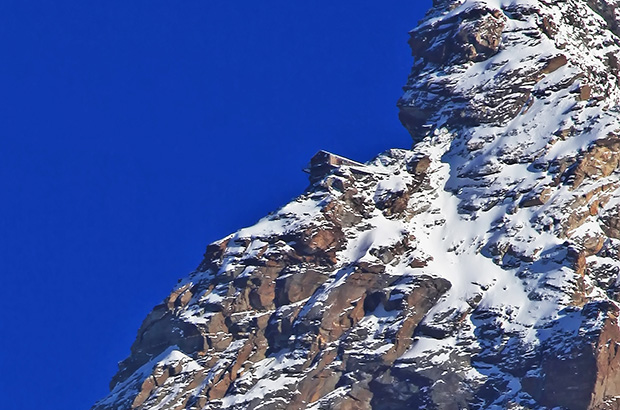
Modern comfortable refuge - Carrel's hut located on a steep section of the Matterhorn South ridge makes this route incomparably more accessible and safer than it was in the days of the pioneers
Here I stumble over another thought: doesn’t the technical progress entail the spiritual regress, a weakening of the will? However, these considerations may lead me far from the topic of my story about Mount Matterhorn.
On August 26, 1891, Jean-Antoine Carrel, the best guide in Italy, a brilliant climber, who had completed dozens of the first ascents of the most difficult mountaineering routes, the founder of the era of sport mountaineering, died of exhaustion on the slope of Testa di Lione while descending from the Matterhorn...
A modest memorial at the base of Mount Matterhorn - in memory of its famous pioneer
Today, the Matterhorn, or Monte Cervino, as this mountain is called in Italy, is one of the most popular Alpine peaks for climbing, the desired goal of many climbers not depending on their nationality.
Our mountaineering plans were ruined due to persistent bad weather. The Monte Rosa traverse, one of the most beautiful routes in the Alps, had to be shortened and limited to just several ascents in the completely disastrous conditions. Climbing Mont Blanc in a snowstorm did not bring the expected pleasure. The next mountain for climbing according to our plan had to be Mount Matterhorn.
However, knowing the nature of this mountain from my previous ascents, I had no illusions about attempting to climb Matterhorn in bad weather...

Officially, mountaineering - that is about beautiful views and happy faces inspired by victory. But that happens not always
...By the dim light of our headtorches, inside the Carrel hut, nestled at an altitude of 3820 meters above sea level on the steep southeastern ridge of the Matterhorn, begins sleepy morning moving. Four people, waking up before dawn, chatting their teeth from the cold, are preparing breakfast and packing their backpacks.
In order to have as much daylight as possible, we, already roped up and wearing crampons, set out to climb as soon as the first signs of dawn appear on the rocks...

Traverse of the rocky pitches above the Carrel hut, Liongrat route
Pre-dawn twilight. The horizon takes a pale pink hue, its dark broken line is separated from the brightening sky, becoming clearer and more contrasting. The sky is clear. The air is totally calm and still, the mountains are still sleeping, smiling like children... It seems that the weather has finally relented and given us a chance for which only our last hope remained. There is no reason for delay anymore, now the way is only upward.
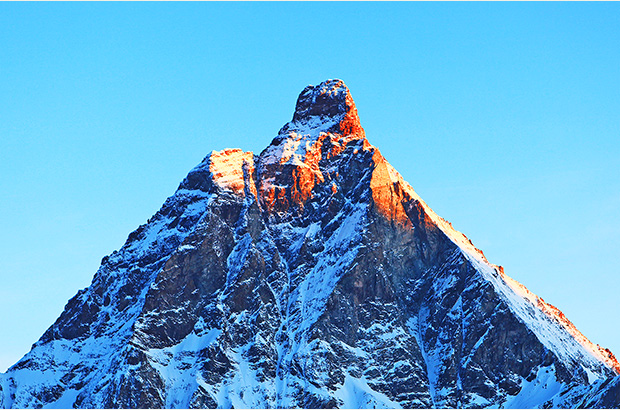
The top of the Matterhorn catches the first rays of the rising sun
Along easy rocks, traversing the side of the steep ridge, we climb to the small gape between two huge rock bastions. The ridge is very broken at the top; you only can move along its eastern side, fallowing a system of small shelves and ledges.
The traverse leads to the base of a 60-meter steep wall. There is a long iron chain hanging here, going far up, beyond the bend of the cornice - it would totally crazy goal to climb up without it. There are several memorial plaques fixed to the rock. Some climbers paid with their lives for the desire to climb the Summit.
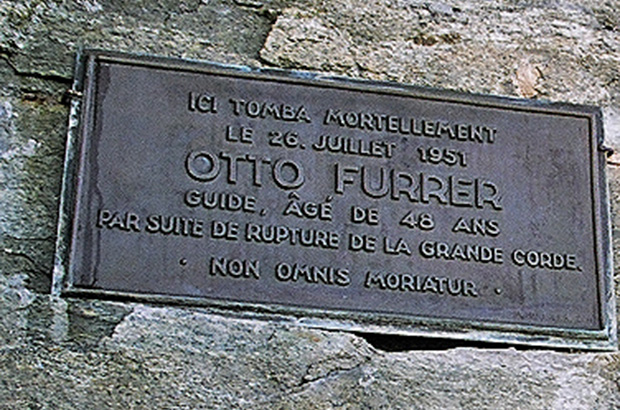
A Swiss guide fell to his death on a rock below Tyndall Peak. The rocks are very bad and loose, sharp, it’s not surprising that the fall ended with the rope breaking
Handling the securely fastened steel links with my hands, I thought about how the pioneers passed here. After all, their equipment only included felt hats, strong hands and an unyielding will to go until the Summit.
From the southeast, sticking to the Summit of Matterhorn there is a narrow rocky shoulder, the so-called Tyndall Peak, whose height is just 250 meters less than the height of the Matterhorn. From here begins the most interesting part of the route - a smooth steep rock, in the upper part covered with ice from the melted snow cap at the Summit.
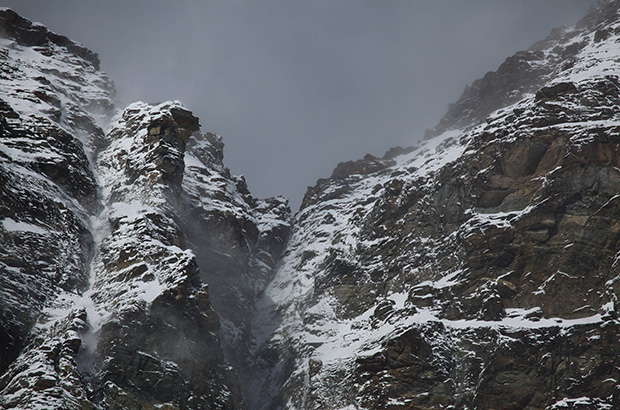
There is a difficulty between Tyndall Peak and the Matterhorn Summit Tower. You need to jump over a 3-meter gap in the rocks. It is not that much, but it’s exciting when there’s a kilometer-deep abyss under you
The entire further route is clearly visible - first up, then climb a little to the right, then up again and traverse to the left to reach the Summit. However, these 250 meters are the crux section of the entire route, its most difficult part, for which you need to mobilize all your remaining power.
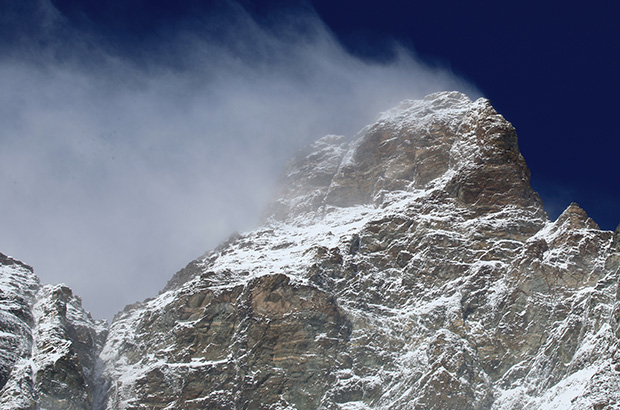
Matterhorn Summit Tower - final 250 vertical meters of sheer wall
Summit. Suddenly, the arch of space unfolds above my head covering me with an attack of dizziness. The horizon opens up to 360 degrees, nothing else obstructs the view. In the north - there are green valleys and snow-white peaks of the Swiss Alps, in the south - there is all Italy to the Mediterranean Sea hiding in a light haze...

All the Alps from the top of Matterhorn to Mont Blanc
I am standing at the very point of a two-kilometer high rock needle, under the bottomless blue dome of the sky, tied with a rope to my partner, but free from everything else in the world.
The feeling of such freedom is alien to human nature, it cannot be preserved, it cannot be carried down from the mountain. Maybe, this is one of the reasons why people climb the highest mountain peaks again and again, risking their lives for a few short moments of the “summit euphoria.”

On the Summit of Mount Matterhorn
The Matterhorn has two summits, separated by a small saddle. One of the tops is “owned” by Italy, the other by Switzerland. It's funny. 70 meters of our climbing rope fixed on the Italian summit was just enough to cross the “border” and get to Switzerland!
At the end of the 19th century, a huge two-meter high iron cross was installed on the Italian summit of Mount Matterhorn. It looks very impressive, especially if you think about the fact that there were no helicopters in these times.

His Majesty the Matterhorn. The route my story is about goes on the left side along the skyline. The pioneer route of Hörnli Ridge along the right skyline also looks impressive
...Time flows differently for mountains and people; human centuries are just seconds for imperturbable stone giants. People come and go, generation follows generation, the history of mankind, like the wind, washes cold granite, leaving no trace on it... Time in the mountains seems to have frozen in stone agony.

In our fast changing world, there are not many things that remain unchanged: the whisper of sea waves, the silent pattern of constellations and the outlines of mountains
If you touch these mossy rocks with your hand, trace the winding pattern of a rock surface with your frozen fingers, you get the similar feeling that you experience if holding a dusty, ancient book in a long-forgotten language... A feeling being close to something very distant. Feeling of touching the Legend.
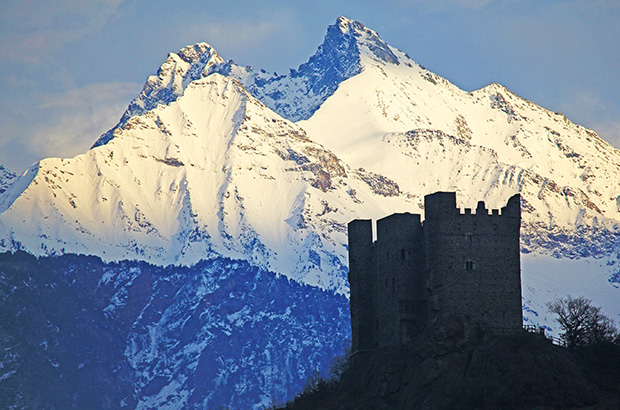
Medieval Ussel castle in Chatillon in the Val d'Aosta valley. Our Matterhorn climb from Italy begins and ends here
12/23/23 Madrid - Venice
The author of the text and (almost all) photographs Alex Trubachev
Your mountaineering, rock and iceclimbing guide in Italy and Switzerland
MCS EDIT 2024
Our Principles
AlexClimb Rule #1 - Safety First
From the very beginning of our activity, here nearly 16 years, the first Principle of work of School of mountaineering and rock-climbing of MCS AlexClimb is the Safety Priority. On the basis of this Principle all process of training is based, all programs and rounds are developed and carried out only within this main principle. We consider that at professional approach to development of programs, at personal discipline and correctly put motivation - occupations by mountaineering and rock-climbing are COMPLETELY safe. And from the return - all troubles and accidents in our sport come from nonprofessionalism, from ignorance or neglect by elementary standards of safety, from irrational motivation, from revaluation of own forces and opportunities. All these prerequisites we COMPLETELY EXCLUDE in our work - ours Rock-climbing, Ice climbing and Mountaineering are based on one Principle - the Safety Priority. In rock-climbing, mountaineering and ice climbing, the Priority of Safety of MCS AlexClimb-is your personal security and comfort irrespective of, than we are engaged - we train muscles and we work technology of the movement in the sports hall and on the rock climbing wall, we make the way through snowstorm to top or we relax on golden sand of the Caribbean beach after hot day of trainings on rocks. The Safety priority - the main credo of School of mountaineering and rock-climbing of MCS AlexClimb.
AlexClimb Rule #2 - Leave No Trace
Closely interacting with Nature, working with the active programs in mountains, woods, lakes and rivers, we perfectly understand the importance of carefull and respectfull bahavior towards the Nature, for its resources. From the very beginning of our outdoor-activity we adopted rules of Leave No Trace technique - the standard of behavior of the person accepted in all the civilized world in relation to environment and especially - to the wild nature. After all on the relation of people to the nature near which they exist, itself can draw dalekoidushchy conclusions on the relation of these people to... Where and as we didn't travel - we don't reserve any garbage, we try to reduce whenever possible our influence on environment to a minimum. We clear earlier zagryazyonny tourist parking of the left garbage, we take out and we take out to utilization places that to us other people left there. We consider that only thus, at personal individual consciousness of each citizen, each tourist, climber or autotraveller, we will be able to keep the nature surrounding us in its state, natural, suitable for life, - in it pledge of the healthy future for ourselves and our children.





